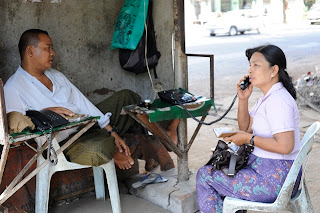 2 posts in under a week! I'm really hoping to get this blog back on track for awhile. I've been pretty lousy at it lately, but we had a huge summer (literally, we both came back from a three-week trip to America significantly heavier than when we left) and then the start of the academic year was upon us and so it goes.
2 posts in under a week! I'm really hoping to get this blog back on track for awhile. I've been pretty lousy at it lately, but we had a huge summer (literally, we both came back from a three-week trip to America significantly heavier than when we left) and then the start of the academic year was upon us and so it goes. Anyway, as our time in Malaysia grows shorter (61 days!) I'm starting to see everything in two categories: what I will miss, and what I will not. Let's take a look:
Things I will miss:
The lovely, lovely weather. 90 degrees every day, guaranteed.
The food. In no particular order: yam basket, banana leaf curry, laksas of all sorts, hokkien mee, steamboat, Chinese pork ribs, salted chilies, the list goes on . . . .
Cheap stuff. Especially: food, haircuts, the vet, gasoline, (really nice) hotels, taxis, the cinema, massages.
Regional travel. So much to see and do, in three years we have covered: Cambodia, Laos, Vietnam, India, Myanmar, Singapore, Indonesia x 2, Thailand x 4 and several good romps around Malaysia including a few trips to Borneo and some totally gorgeous islands.
Cheap regional airfare. Or how else would we have managed the above? AirAsia, I love you.
Under the sea. This part of the world has possibly made snorkeling my new favourite activity. Rays, octopus, starfish, clownfish, amazing corals. Can't get that just anywhere.
Wildlife. Orangutans, elephants, proboscis monkeys, hornbills, giant lizards, sea turtles. Even the little geckos.
Having a swimming pool. There is a very nice pool about 20 feet from my front door.
Thunderstorms. Totally epic, torrential, noisy, tropical thunderstorms.
Never ever being cold. You know what it's like to get out of bed at 7am in January in Illinois? I don't.
About a billion public holidays. When you observe Muslim, Christian, Buddhist, Hindu and national/state holidays that adds up to a lot.
The diversity. There's a lot of different people here. I like that.
*And this really goes without saying, but of course all of our amazing Malaysian and fellow expat friends who we've met along the way.
Things I will not miss:
Driving. Everything about it.
Trying to get stuff done. It's so hard to get the simplest things done here sometimes. Want to pay your internet bill? Must call them up and do it over the phone (Oh! The irony). Need a plumber? Take three consecutive days off work and pray he shows up by the third day. Want to deposit a cheque? Good luck finding the 'special' deposit machine for foreigners.
Calling strangers on their mobile. See above. Lots of businesses and tradesmen are not online, so you can't look them up online or book an appointment. Instead, you ask around, you get some guy's mobile number and hope for the best.
Bureaucracy. There is a form and a supplementary price for everything.
Negotiating. I hate haggling and negotiating, I don't want to be ripped off and I don't want to rip you off. Just tell me the real (fair) price.
Sugar. It's in everything.
Spitting, hawking, chewing, slurping. I know it's a cultural thing, but I don't like it.
Littering. Is there really no space in your car for that empty packet of crisps? Really?
Cockroaches. Really big ones.
Lack of personal space. The pushing, shoving, me-first battle of boarding a plane, train or just standing in what passes for queue here.
No means no. If I said I don't want to buy it, I really mean it. Also, don't follow me around the store.
Palm oil plantations. Please, please stop destroying your beautiful country.
Sopping wet toilets. With or without footprints on the seat, this really irritates me. If part of your bathroom ritual basically involves taking a shower, that's fine. Just please wipe up the mess.
And did I mention DRIVING?


























